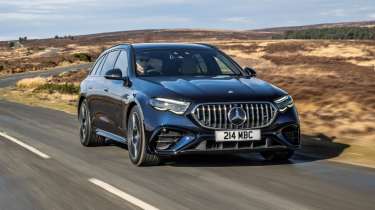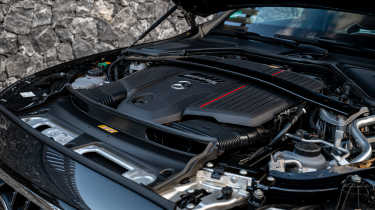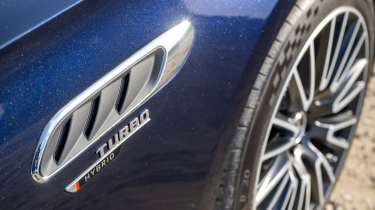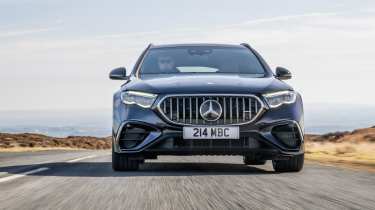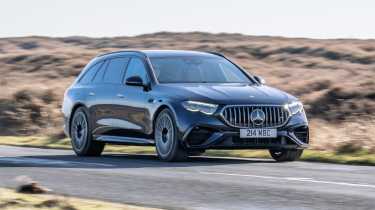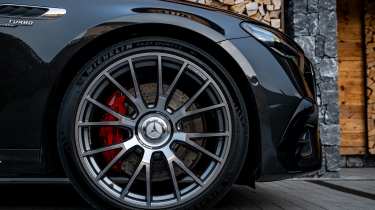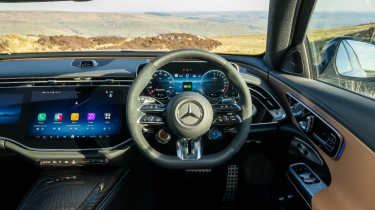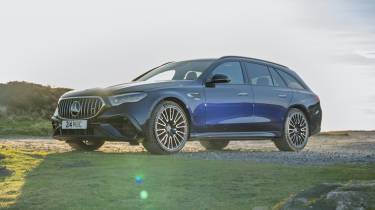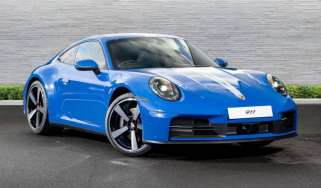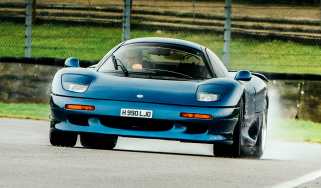Mercedes-AMG E53 2025 review – this isn't AMG's BMW M5 rival
With no V8 flagship estate, this six-cylinder hybrid feels like an interim leader, even if it has its own merits
evo verdict
The Mercedes-AMG E53 is a well-made, handsomely styled performance offering that sports a lot of big numbers. The trouble is, compared to the dearly departed E63, power and cylinder counts are down, while weight is significantly up. To consider this a new entry in the dynasty of hot rods that ended with that car would be wrong and ultimately, a disservice to the E53 and its commendable technical appointment – it’s impressively agile with good damping and body control, not to mention effortlessly fast and refined.
Its hybridity adds versatility and capability the old V8 couldn’t hope to replicate, but there’s no ignoring that the E53 doesn’t inherit the old car’s charisma and personality. This is not a Mercedes-AMG flagship supersaloon and estate as we knew and loved them. It’s a fast, capable, technically impressive but ultimately slightly cold £90k E-class.
Mercedes-AMG E53 in detail – background and model range
Given Mercedes-AMG is not planning to build a new E63, for the foreseeable future, this is the most potent Mercedes E-class you can get: the new Mercedes-AMG E53 performance hybrid, available as either a saloon or estate. In terms of pricing and performance, it's positioned between the top-end BMW 5-series that is the M550e and the full-fat M5.
More reviews
In-depth reviews
Reviews
- Mercedes-Benz E55 AMG (W211, 2003 - 2006): review, specs and buying guide
- Mercedes E-class 2024 review – plug-in hybrid E300e tested
- Mercedes-AMG E53 2021 review – brimming with tech, but missing the charisma of an M550i
- Mercedes E-class 2020 review – new E450 a smooth operator
- New Mercedes-Benz E-class review
- Mercedes E400d AMG-Line estate review
It’s AMG’s first long-range hybrid, a plug-in with a total power output of 577bhp (more in ‘Race Start’ mode) and a 57-mile all-electric driving range. While a fast car, it’s also an easy-going, refined one, based on our first experience of it both on the launch and during our week with the car on the road in the UK. We covered several hundred miles during our time with the E53, from motorway schleps to countryside thrashes, to village bimbles, across to Bicester Heritage and Caffeine and Machine, using petrol and electric power.
The E53 is at the head of the E-class range that starts with the E200 AMG Line saloon for £56,650 all the way up to this £90k+, near-600bhp ubermachine. The E-class is unique among its rivals in 2025 in still offering a number of diesel options, including long-range plug-in hybrids, topping out with the E450d with 390bhp. The E450d and the E53 are the only six-cylinder models in the E-class range, with the lesser e300e and e300de using four-cylinder petrol and diesel engines. While the E450d is a delightfully torque-rich esoteric option in 2025, it’s the AMG-spec E53 flagship that is the E-class of most interest to evo. It certainly looks the part, with its broader stance, bigger intakes, AMG crest and grille, quad exhausts and big wheels. Does its bite match the visual bark?
Engine, gearbox and technical highlights
- Combined 577bhp and 553lb ft includes 134bhp from the gearbox-mounted e-motor
- 28.6kWh battery allows 57-mile electric range, pads out c2400kg kerb weight
- E53 manages that weight with adaptive damping and rear-wheel-steering
The 577bhp E53 combines a 443bhp 3-litre straight-six with a 120kW electric motor, integrated into the transmission between the engine and gearbox (a nine-speed auto). An electronically controlled limited-slip differential can be fitted at the rear as an option (also part of the AMG Performance pack, more on which later), while the front diff is open but assisted by torque vectoring
Red borders to the E53 badge on the bootlid identify this as a plug-in AMG, as they do on the C63. The hybrid powertrain makes this a heavy car. The saloon weighs 2315kg, and the estate 2380kg. To manage the mass and afford the E53 the level of control and composure you’d expect of a high-performance executive car, it employs steel springs and Bilstein adaptive two-valve dampers, with three different selectable modes.
The E53 is a bit wider than a normal E-class, with wider tracks front and rear and much wider wheels: 265mm wheels at the front. There are totally different suspension kinematics compared with a regular E-class for this AMG version. It’s a large car too at almost 5 metres long and over 2-metres wide, with a near 3-metre wheelbase. To keep the vast E53 wieldy, it has rear-wheel-steering. Below 62mph, the rear wheels turn in the opposite direction to the fronts by up to 2.5 degrees for manoeuvrability at parking speeds or agility on the move. Above 62mph they turn in the same direction as the fronts, at up to 0.7 degrees, for stability.
Underbody stiffness is increased compared to a standard E-class, and there’s a strut brace between the front suspension turrets. There are additional measures beneath the engine to alter the front load paths and stiffer mounting solutions for the rear suspension too, for greater precision.
Power, torque and 0-62mph time
| Model | Power | Torque | Weight | 0-62mph | Top speed |
|---|---|---|---|---|---|
|
Mercedes-AMG E53 saloon Mercedes-AMG E53 estate | 577bhp | 553lb ft |
2315kg (saloon) 2380kg (estate) |
3.8 - 4sec 3.9 - 4.1sec |
155-174mph 155-171mph |
The combustion engine is essentially the same as that in the Mercedes-AMG CLE 53, barring a few tweaks here and there, but the big difference is that the E53 is a plug-in hybrid with a considerable electric-only range, whereas the CLE 53 hybrid isn’t a plug-in. The M256 is a family of engines, with the version in the E53 at the head, rather than a bespoke engine. It features in a lesser state of tune in the CLE 450. In AMG spec, there’s increased boost pressure, revised piston rings to cope and revised combustion chambers.
Total system output from the turbocharged engine and motor working together is 577bhp and 553lb ft. Technically, the E53 is capable of a higher-still power output than its 577bhp system total: Race Start mode – available as an option with the AMG Performance package and AMG Driver’s Package – gives you a temporary 612bhp total output, albeit only momentarily from a standing start.
With this potency fully deployed, even in spite of the weight, the saloon takes 3.8sec to get from 0-62mph, with the optional Race Start system (or 4sec without). The slightly heavier estate takes 3.9sec and 4.1sec with/without the Race Start system. Top speed is electronically limited to 174mph for the saloon (with the optional AMG Driver’s Package; otherwise it’s limited to 155mph, as is the estate). The E53 estate’s top speed is 171mph with the option pack.
Both the motor and engine power all four wheels, and in theory the E53 features a ‘fully variable’ torque split via an electromechanical clutch, although in practice, a certain amount of torque is always sent to the front wheels, for the purpose of torque vectoring without delay. A certain amount of charge in the battery is always set aside by the powertrain management software for this purpose.
The 400V, 28.6kWh battery is located under the boot floor, meaning a slightly smaller ultimate boot capacity than other E-class variants. While 26.8kWh is the gross capacity, everyday usable capacity is 21.6kWh – partly because the aforementioned need to set aside a certain amount of charge for performance and torque vectoring. All UK cars get the 60kW DC fast-charger system as standard (models in Germany have an 11kW AC charger as standard, with the 60kW kit an option).
The E53 can travel at 87mph powered by its electric motor alone, and a quoted 59-mile range means plenty of average users’ average journeys can theoretically be completed purely in electric ‘EL’ mode. In electric mode, there are also three different regenerative braking modes which can be toggled by the driver: a heavy regen mode, akin to one-pedal driving; an auto setting, where the amount of regen is continually altered on the fly; and a minimal recuperation mode for less abrupt deceleration.
The E53’s plug-in hybrid powertrain is also fitted to the Mercedes-AMG GLE 53 SUV model, although that car won’t be sold in the UK.
Driver’s note
“The Mercedes-AMG E53 has much of the perceived performance of the bygone 63-badged cars and if anything, greater capability, without much of the character or drama.” – Ethan Jupp, evo web editor, who tested the Mercedes-AMG E53 on the road in the UK
Performance, ride and handling
- Powertrain is laden with potency if not personality
- Damping, body control and overall agility are impressive
- Brake consistency and feel and steering feel less so
When you first switch the car on, the EL electric mode is the default setting. The E53 has several further settings, all selected via the little rotary switch mounted to the steering wheel: Comfort, Sport, Sport + and Battery Hold to retain the battery’s current state of charge to deploy later, when you reach a city, for example.
As a default, unless you change the drive mode before driving off, the E53 pulls away using its electric motor only. After all, it can deliver its maximum torque of 354lb ft from effectively 0rpm. If you need more power, or the battery’s running low, it automatically – and smoothly, it must be said – brings the engine into play and switches to the Comfort drive mode.
When the engine is in play, its power delivery is nice and smooth, and the E53 is a pleasantly, if undramatically, swift car to drive. There’s not much drama to the engine’s delivery, with no frantic rush to the top end or barrel chest to its vocal range, but it is flexible and refined. You can artificially enhance the sound in the option menus, but it sounds at its best – and most like a classical straight-six – when left to its natural sound. It’s at its enhanced noisiest in Sport+ mode, but you can toggle the sound off, via the touchscreen or configurable shortcuts on the wheel, and save your preference in Individual mode. Under heavier acceleration, the exhausts make that slightly flatulent (and slightly contrived) sound on upshifts that’s a hallmark of cars such as these.
Given the considerable amount of torque, and the interplay between motor and engine, the E53 doesn’t always allow manual downshifts as freely as you might expect on the paddles, and you sometimes need to let the revs drop a little lower than feels natural before you call on a lower gear, but shifts from the nine-speed ’box are smooth and swift when they are carried out as instructed. Refinement is very good: this is a very quiet car at a cruise, with a little road noise from the wide tyres but impressively well suppressed wind noise and powertrain noise.
The damping is impressive: it’s certainly firm, as you’d expect from a performance car, but it’s high-quality in the way it controls the body’s movements and even in its firmest Sport+ setting, the E53 is a comfortable car on most surfaces. The roads on the German and Austrian test route we initially tried the E53 on were relatively smooth, however further testing in the UK has revealed the E53’s damping stands up to the rigours and ruts of our potted highways, the mega Merc shrugging off all but the nastiest bumps, fissures and holes it passed over. The E53 copes well with diagonal inputs through the car at higher speeds, for example crossing a ridge in the road surface during cornering, too.
Our route on the launch took in a mix of autobahn and mountain roads, with occasional urban sections. Rear-wheel steering is standard, and boosts the E53’s agility considerably. You can definitely feel the system in operation, and it’s not as unobtrusive as in some cars, but it soon feels relatively natural and works well – an assessment latterly backed up in the UK. The physically broad E53 should by rights feel like a prize atlantic tuna in a garden fishpond on the skinny, sweeping and unsighted lanes of Bedfordshire but the rear-steering – and crucially its calibration and integration – render the E53 a natural and wieldy machine to thread around to the point that on the occasion you give more than a passing glance to the sprawling real estate of cabin behind you, it takes you by surprise.
At higher speeds on the autobahn (at one point we reached more than 160mph in the saloon), you can feel a bit of lift at the front, but that’s not unusual for a car like this and overall stability is confidence-inspiring. Less so the chunky steering wheel, which makes it difficult to fit your hands around perfectly (it’s the same wheel fitted to other AMG modes such as the C63, SL and AMG GT, with frustrating touch-sensitive surfaces on the spokes to control various functions). That said, it’s not as difficult to grasp cramp-free as an equivalent BMW rim.
All the same it exacerbates the slightly numb-feeling steering, which is not particularly communicative. It is very well insulated from kickback and cambers, however, and it’s very accurate – it’s quite a fast steering set-up, and you don’t need much lock for tight corners (particularly at low speeds, with the rear-steer in action). That can feel a bit odd at first, but you quickly get used to it, and the E53 does feel a nimble car that’s keen to change direction, despite its heavy kerb weight. It feels lighter than it really is; a little like the AMG GT, in fact.
The brakes blend regular friction braking and motor regen, and do feel odd at times as a result. The E53 uses a vacuum-independent electromechanical brake booster to combine the regen and hydraulic braking. It varies the braking power of the hydraulic system on the fly, the aim being consistent brake pedal pressure from the driver with the ratio of hydraulic braking and motor braking being adjusted behind the scenes without affecting the feel through the pedal. Pedal feel is certainly less vague than some hybrids and the E53 stopped well during our testing, but you don’t quite have the total consistency and feedback you get from a traditional pure friction brake system.
Despite the difference in weight between the saloon and estate, they feel practically identical to drive. And they are effectively identical mechanically, just with a few very minor changes to spring rates and damper calibration for the estate.
Driver's note
“I enjoyed driving the E53 very much. It’s an excellent long-distance car, with impressive damping and a good level of nimbleness considering its size and weight. Its weak point is that it’s not a very dramatic or memorable car; not a car in which you’d remember a drive vividly after the fact, or plan a driving expedition in.” – James Taylor, evo deputy editor, who tested the Mercedes-AMG E53 on the road in the UK.
MPG and running costs
- Electric range is reasonably impressive
- Petrol engine is dependably efficient in normal use
- Purchase price rather than emissions yields the biggest tax penalty
Plug-in hybrid fuel economy is always open to conjecture, and highly dependent on use scenarios, but Mercedes-AMG’s official fuel consumption figures with the battery discharged on a combined route (urban and extra-urban) are 29.7-32.8mpg.
In our testing we found that to be more or less accurate, with the E53 delivering in the region of 30mpg on a steady but swift combustion-engined motorway cruise. Also worth noting is the electric range. While the car’s indicated figures for a full charge don’t quite match the claimed 57-mile figure, the car is true to its own predictions of 40-50 miles depending on how you’re using it.
Company car buyers will see the appeal of the PHEV E53, as it falls within the relatively palatable nine per cent bracket, rising to ten per cent in 26/27 and 11 in 27/28. Being a £90,000+ car from new, the E53 is liable for the government’s ‘expensive car supplement’, adding £425 per year to the VED bill for its first five years on the road. The base tax bill is low however, falling into the 1-50g/km bracket of £110 for first registration, rising to £195PA at the beginning of its second year.
Predicted depreciation is at around 16 per cent for the E53, leaving it within the region of £78,000 at the end of the first year. The Mercedes-AMG E53 is insurance group 50, typical of high-performance models, making it predictably expensive to insure.
Interior and tech
- Solid fit, finish and material quality
- Partly due to fewer individual pieces thanks to vast, relatively intuitive ‘superscreen’
- Steering wheel oddly shaped with some background low-quality plastics
Interior fit and finish felt very good in the cars we drove on the launch – more so than other Mercedes models we’ve tested of late. There are fewer creaks from low-quality plastics than say, a CLE, though you will find some. Rap your fingers against the back of the drive mode controllers on the steering wheel in time with a song and you’ll be met with a tinny plasticcy rattle. There are different steering wheel options, with leather standard and a carbon/microfibre combo an option.
The test cars were equipped with the ‘MBUX super screen’ option, with a giant central touchscreen alongside the digital instrument panel behind the wheel and a third screen for the front-seat passenger to play with. The E53 gets various AMG-specific displays, hybrid-related extras such as a charging menu, battery status and so on.
Seats and boot space
There are multiple seat options, and our test cars were fitted with the optional AMG Performance seats, with a racerish shape and perforated man-made leather upholstery. They look great, and felt great on a long journey too, with support in all the right places for our tall-ish testers. Seats are a very subjective thing however and these buckets won’t be to all tastes – try before you buy.
Head and legroom are generally strong in both the E53 saloon and estate, with plenty of space for four adult passengers. Boot space is compromised on the hybrid thanks to the battery being under the boot floor. Where non-PHEV E-class models boast 615 litres of boot space, the E53 is way down, with just 460 litres. In the real world, it’s still a long, comparatively practical boot space, with split folding rear seats.
Price and buying options
The Mercedes-AMG E53 is not a cheap car. At the time of writing (May 2025) it starts at £92,120 for the saloon and £94,370 for the estate. Deliveries began in the fourth quarter of 2024.
There are two trim levels at launch in the UK – Premium and Night Edition Premium Plus – plus the limited-run Edition 1 spec. Different Night Package options swap the usual chrome for black trim. 21-inch forged alloy wheels are standard in the UK.
The AMG Performance Package, as fitted to the cars tested here, costs £7495 and bundles together options including:
- The Dynamics Plus package: bigger brakes (390mm front discs with six-piston calipers, compared with the 370mm four-pots as standard, and red calipers), active engine mounts and an electronically controlled limited-slip diff at the rear.
- The AMG Driver’s package, including the top speed increase
- The AMG Performance seats and steering wheel trim
- The ‘Night Package II’, i.e. a dark grille and other black exterior trim bits
- The Race Start function
The package is available for both the saloon and estate in Night Edition Premium Plus trim, and priced the same for both. It’s standard on the Edition 1 and we’d say, certainly worth getting if you enjoy driving and an E53 is to be your only performance car.
Rivals
The E53 is a slightly confusing car in terms of its positioning. Though it packs a visual punch, by the numbers – both in terms of performance and price – and by the driving experience this is definitively not a full-on BMW M5 rival.
Then again by those same numbers, it’s something altogether more potent and capable than say, the M550e. If the latter isn’t enough but an M5 is too much, then maybe the E53 is the ideal middle ground. The E53’s comparative lack of drama could be a strength for some buyers. If you want a refined, comfortable, swift and posh-feeling performance saloon or estate, you may find there’s plenty to enjoy here.
It is not the ideal next car for someone coming out of an E63, who had a particular love for that car’s personality. To those, we’d suggest questioning whether an M3 saloon or M3 Touring for around the same money as an equivalent E53, would actually be too small for them. Or, we’d suggest perhaps looking for a deal on the few remaining new C8 Audi RS6s Audi UK has left in stock. Or, just stick with that E63…
| Model | Power | Torque | Weight | 0-62mph | Top speed | Price |
|---|---|---|---|---|---|---|
| Mercedes-AMG E53 | 577bhp | 553lb ft | 2315kg-2380kg | 3.8 - 4.1sec | 155-174mph | From £92,120 |
| BMW M5 | 717bhp | 737lb ft | 2435kg | 3.5sec | 155-189mph | From £111,515 |
| BMW M550e | 482bhp | 516lb ft | 2230kg | 4.3sec | 155mph | From £76,715 |
| BMW M3 Touring | 520bhp | 479lb ft | 1940kg | 3.6sec | 155-174mph | From £91775 |
